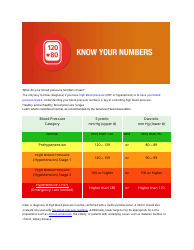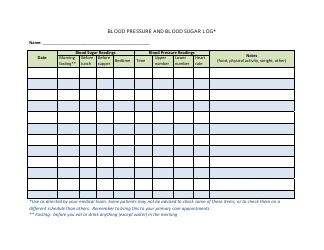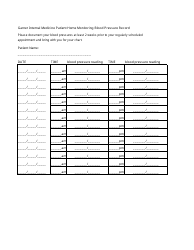Blood Pressure Chart - Varicolored
A blood pressure chart is used to track and monitor a person's blood pressure readings over time. It helps to determine if the blood pressure is within a healthy range or if there is a need for medical intervention.
The individual who measures their blood pressure usually files the blood pressure chart. They can keep the chart for personal reference or share it with their healthcare provider.
FAQ
Q: What is a blood pressure chart?
A: A blood pressure chart is a visual representation of the different blood pressure ranges.
Q: Why is a blood pressure chart important?
A: A blood pressure chart is important because it helps identify if blood pressure is within a healthy range or if it is too high or too low.
Q: What are the categories of blood pressure on a chart?
A: The categories on a blood pressure chart typically include normal, elevated, stage 1 hypertension, stage 2 hypertension, and hypertensive crisis.
Q: What is considered normal blood pressure?
A: Normal blood pressure is typically defined as systolic pressure below 120 mmHg and diastolic pressure below 80 mmHg.
Q: What is elevated blood pressure?
A: Elevated blood pressure is when the systolic pressure is between 120-129 mmHg and the diastolic pressure is below 80 mmHg.
Q: What is stage 1 hypertension?
A: Stage 1 hypertension is when the systolic pressure is between 130-139 mmHg or the diastolic pressure is between 80-89 mmHg.
Q: What is stage 2 hypertension?
A: Stage 2 hypertension is when the systolic pressure is 140 mmHg or higher, or the diastolic pressure is 90 mmHg or higher.
Q: What is a hypertensive crisis?
A: A hypertensive crisis is when the systolic pressure is over 180 mmHg and/or the diastolic pressure is over 120 mmHg. This requires immediate medical attention.
Q: Why is it important to monitor blood pressure?
A: Monitoring blood pressure is important to detect and manage conditions such as hypertension, which can increase the risk of heart disease and other health problems.
Q: How can I maintain a healthy blood pressure?
A: Maintaining a healthy blood pressure includes adopting a healthy lifestyle, such as eating a balanced diet, exercising regularly, managing stress, and avoiding tobacco and excessive alcohol consumption.




















